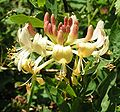Lepidopterophilia
Lepidopterophilia describes the trait syndrome in plants that is associated with entomophilic insect pollination by butterflies (Lepidoptera). There are clear differences, whether the pollination is done by butterflies or by night butterflies (neither of which are taxa ). In any case, nectar is offered as a reward, which the butterflies ingest with their proboscis . A distinction is made between different subspecies of butterfly pollination:
- Phalenophilia (moths)
- Pyrilidophilia (borer)
- Psychophilia (butterflies)
- Sphingophilia (moth)
- Phalaenophilia (night owls)
Psychophilia
Psychophilia is the adaptation to pollination by butterflies. This syndrome includes long- tube flowers or stem-plate flowers, which are tubular flowers combined with a landing site for pollinators. The nectar is hidden up to 40 mm deep in the mostly narrow tubular flowers. The flower color is often red, also blue, yellow, rarely white. Flower marks are common. The flowers do not smell intensely and - for humans - pleasant. Often come Schaukelantheren ago.
A typical butterfly flower is the fire lily ( Lilium bulbiferum ): The nectar is formed in narrow channels on the tepals . The tepals of the Turk's Union lily ( Lilium martagon ) are turned back and so smooth that the butterflies cannot land. They are therefore pollinated by the pigeon tail ( Macroglossum ) in hovering flight . Butterfly flowers are widespread among the carnation family, such as red light carnation ( Silene dioica ), corn leaf ( Agrostemma githago ), the cruciferous family (Brassicaceae), and the cardiac family (Dipsacaceae).
Important representatives of pollinators are the thick-headed butterflies (Hesperiidae), bluebells (Lycaenidae), spotted butterflies ( Nymphalinae ), whiteflies (Pieridae) and knight butterfly (Papilionidae).
Sphingophilia
Sphingophilia is the adaptation to pollination by moths. The syndrome usually involves very long tubular flowers. Often there is no possibility of landing (night owl flowers). The nectar can be hidden 20 centimeters deep, sometimes even deeper. The flower color is mostly white. The flowers often smell intensely perfumed. Here, too, rocking anthers occur. The anthesis and the fragrance release take place at night.
The pollination takes place here frequently in hovering flight by representatives of the swarmers (Sphingidae). The owl butterflies (Noctuidae) need a landing place. These are offered by white-flowering carnations such as the white light carnation ( Silene alba ).
Honeysuckle ( Lonicera ) are characteristic swarmers : the corolla tube is long and smooth, the rocking anther protrudes far. In the forest honeysuckle ( Lonicera periclymenum ), when the flower turns yellow, it indicates that it is no longer offering any nectar.
The brush flowers of the real caper bush ( Capparis spinosa ) are also pollinated by moths.
Phalaenophilia
Sometimes phalaenophilia is separated from sphingophilia: pollination by moths that need a landing site, such as the owl butterflies. Sphingophilia is then more narrowly defined than pure swarm pollination.
supporting documents
- Peter Leins: blossom and fruit. Morphology, history of development, phylogeny, function, ecology . E. Schweizerbart'sche Verlagsbuchhandlung, Stuttgart 2000, pp. 233-237. ISBN 3-510-65194-4 .
- Joey Lukas: Psychophilia and Sphingophilia. Adaptation of flowers to pollination by butterflies. Grin, March 28, 2018, ISBN 3-668-67115-X , ISBN 978-3-668-67115-7 .
Individual evidence
- ↑ Keywords "sphingophil" and "phalaenophil" in: Matthias Schaefer: Dictionary of Ecology . 4th edition, Spektrum Akademischer Verlag, Heidelberg, Berlin 2003. ISBN 3-8274-0167-4 .







